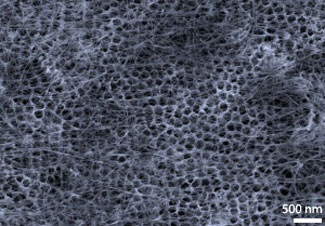| Oct 03, 2011 |
A dye-sensitized solar cell based on a single wire could lead to photovoltaic textiles
|
|
(Nanowerk News) The development of new types of solar cells that are lighter and more flexible than conventional silicon-based designs will open up a range of new applications for photovoltaics. Dye-sensitized solar cells (DSSCs) offer these advantages as well as promising much lower fabrication costs. Anyuan Cao, Zuqiang Bian and colleagues from Peking University in Beijing, China, have now expanded the range of possible applications of DSSCs by developing a single-wire design that could be assembled into large arrays ("Single-Wire Dye-Sensitized Solar Cells Wrapped by Carbon Nanotube Film Electrodes").
|
|
Dye-sensitized solar cells are thin-film devices that can be fabricated from inexpensive and widely available compounds using relatively straightforward electrochemical processes. The structure of a DSSC itself is also quite simple, consisting of an anode and cathode immersed in an electrolyte. The anode of DSSCs is typically made of a mixture of a dye to absorb light and generate free positive and negative charges, and titanium dioxide to act as a conduit that allows the charges to travel to their respective electrodes and produce an electrical current.
|
 |
| Scanning electron microscopy image of a DSSC wire showing the carbon nanotube network. (© 2011 ACS)
|
|
Cao, Bian and their colleagues miniaturized the DSSC design down to the scale of micrometer-sized single wires by wrapping a titanium wire, the anode, with a layer of titanium dioxide tubes filled with a dye. Wrapped around this is an outer layer made of a carbon nanotube mesh, which serves as the cathode (see image). The carbon nanotubes are electrically conducting and have the benefit of being almost transparent, making them ideal for maximizing the amount of light that can reach the dye.
|
|
The wire-based DSSCs displayed promising solar conversion efficiency, at 1.6% for each wire. Although this level of efficiency remains far below the benchmark results for DSSCs, significant improvements are expected by optimizing the wire design, notes Bian. For example, the electrical conductivity of the carbon nanotube layer could be enhanced, and multiple wires could be integrated into a single device to produce larger wire meshes.
|
|
According to Bian, the possible applications of this DSSC structure could include photovoltaic 'textiles'. "The use of fiber-shaped cells would provide flexibility and the cells could be easily integrated into items such as clothes, bags and curtains," he says.
|

